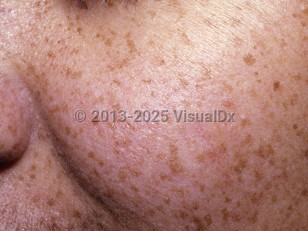Ephelides in Adult
Alerts and Notices
Important News & Links
Synopsis

Ephelides, commonly known as freckles, are a frequent finding in children and adolescents on sun-exposed surfaces including the arms, shoulders, and face. They are not present at birth and start to appear during the first 3 years of life. They are usually 1-3 mm in diameter but can be larger. They are usually light brown, darken in the summer, and fade without sun exposure. They may increase in number during childhood and become confluent. Thereafter, they tend to fade, but sometimes, they may persist into adulthood.
The pigment in ephelides occurs due to an increased number of melanized melanosomes and increased transportation of these melanosomes from melanocytes to keratinocytes. The gene encoding for melanocortin-1 receptor plays a role in the development of ephelides. Individuals with light skin phototypes and blond or red hair, and those with a family history of ephelides, are at a higher risk of developing these lesions.
Ephelides are benign and do not undergo malignant transformation. However, they are markers of ultraviolet (UV) damage and therefore may signal an increased risk of UV-induced skin malignancies including melanoma.
Multiple simple lentigines can be seen in genetic conditions such as Carney complex (LAMB / NAME syndromes), LEOPARD syndrome, Laugier-Hunziker syndrome, Bandler syndrome, and Peutz-Jeghers syndrome.
The pigment in ephelides occurs due to an increased number of melanized melanosomes and increased transportation of these melanosomes from melanocytes to keratinocytes. The gene encoding for melanocortin-1 receptor plays a role in the development of ephelides. Individuals with light skin phototypes and blond or red hair, and those with a family history of ephelides, are at a higher risk of developing these lesions.
Ephelides are benign and do not undergo malignant transformation. However, they are markers of ultraviolet (UV) damage and therefore may signal an increased risk of UV-induced skin malignancies including melanoma.
Multiple simple lentigines can be seen in genetic conditions such as Carney complex (LAMB / NAME syndromes), LEOPARD syndrome, Laugier-Hunziker syndrome, Bandler syndrome, and Peutz-Jeghers syndrome.
Codes
ICD10CM:
L81.2 – Freckles
SNOMEDCT:
403536009 – Ephelis
L81.2 – Freckles
SNOMEDCT:
403536009 – Ephelis
Look For
Subscription Required
Diagnostic Pearls
Subscription Required
Differential Diagnosis & Pitfalls

To perform a comparison, select diagnoses from the classic differential
Subscription Required
Best Tests
Subscription Required
Management Pearls
Subscription Required
Therapy
Subscription Required
References
Subscription Required
Last Reviewed:09/11/2018
Last Updated:09/11/2018
Last Updated:09/11/2018
 Patient Information for Ephelides in Adult
Patient Information for Ephelides in Adult
Premium Feature
VisualDx Patient Handouts
Available in the Elite package
- Improve treatment compliance
- Reduce after-hours questions
- Increase patient engagement and satisfaction
- Written in clear, easy-to-understand language. No confusing jargon.
- Available in English and Spanish
- Print out or email directly to your patient
Upgrade Today

Ephelides in Adult

